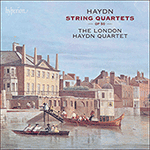
Welcome to Hyperion Records, a British classical label devoted to presenting high-quality recordings of music of all styles and from all periods from the twelfth century to the twenty-first.
Hyperion offers both CDs, and downloads in a number of formats. The site is also available in several languages.
Please use the dropdown buttons to set your preferred options, or use the checkbox to accept the defaults.

| The London Haydn Quartet» More |
The gracious A major theme of the Andante provides necessary balm. But a subterranean cello growl heralds an A minor section whose dissonant harmonies and free contrapuntal textures evoke the world of the first movement. The two sections are then varied with more elaborate figuration, playfully decorative in the A major music, agitated in the A minor. After a second A major variation that pits second violin and viola against the first violin, the ending is as abrupt as that of the first movement.
The minuet replicates the Andante’s major–minor contrasts. Its main section, in F sharp major, worries insistently at its opening figure, and features an almost brutal swerve to the ‘Neapolitan’ chord of D major, fortissimo. Far from easing the tension, the F sharp minor trio is a quiet, single-minded contrapuntal development of the minuet itself, with the viola taking the lead.
Haydn closes with a rapid fugue, as he had done in three of the Op 20 quartets, colouring Baroque techniques with the drama of his sonata style. The tortuous subject outlines the interval of the diminished seventh, a crucial sonority in the first three movements; and in his quest for unity Haydn incorporates links with earlier events, not least the explosive fortissimo climax on an alien chord of G major near the end: perhaps the most violent climax in any Haydn quartet to date, and an echo of the dramatic ‘Neapolitan’ move in the minuet.
from notes by Richard Wigmore © 2016
Le gracieux thème en la majeur de l’Andante apporte un baume nécessaire. Mais un grondement souterrain de violoncelle annonce une section en la mineur, dont les harmonies dissonantes et les textures contrapuntiques libres évoquent l’univers du premier mouvement. Les deux sections sont ensuite variées avec une figuration plus élaborée, malicieusement ornementée dans la partie en la majeur, agitée dans celle en la mineur. Après une seconde variation en la majeur qui oppose le second violon et l’alto au premier violon, la fin est aussi abrupte que celle du premier mouvement.
Le menuet reproduit les contrastes majeur–mineur de l’Andante. La section principale, en fa dièse majeur, joue avec insistance avec sa figure initiale et présente une embardée presque brutale vers l’accord «napolitain» de ré majeur, fortissimo. Loin de soulager la tension, le trio en fa dièse mineur est un développement contrapuntique calme et résolu du menuet lui-même, où l’alto prend la direction des opérations.
Haydn conclut sur une fugue rapide, comme il l’avait fait dans trois quatuors de l’op.20, colorant les techniques baroques avec le drame de son style sonate. Le sujet tortueux trace les contours de l’intervalle de septième diminuée, sonorité essentielle des trois premiers mouvements: et dans sa quête d’unité, Haydn incorpore des liens avec des événements antérieurs, entre autres le sommet fortissimo explosif sur un accord étranger de sol majeur près de la fin: peut-être le sommet le plus violent de tous les quatuors de Haydn écrits jusqu’alors, et un écho de l’effet «napolitain» dramatique dans le menuet.
extrait des notes rédigées par Richard Wigmore © 2016
Français: Marie-Stella Pâris
Das anmutige A-Dur-Thema des Andante bietet den nötigen Balsam. Ein unterirdisches Cello-Grollen leitet jedoch einen a-Moll-Abschnitt ein, dessen dissonante Harmonien und freie kontrapunktische Strukturen sich in die Sphäre des ersten Satzes zurückbegeben. Diese beiden Abschnitte werden dann mit kunstvolleren Figurationen variiert, was die A-Dur-Musik verspielt und dekorativ, die a-Moll-Musik hingegen erregt erklingen lässt. Nach der zweiten A-Dur-Variation, in der die zweite Geige mit der Bratsche gegen die erste Geige gesetzt wird, kommt das Ende ebenso abrupt daher wie im ersten Satz.
Im Menuett werden die Dur–Moll-Kontraste des Andante weitergeführt. Im Hauptteil (Fis-Dur) stellt sich bei der Anfangsfigur ein hartnäckiger Verdruss ein und später kommt ein fast brutaler Schlenker zum „neapolitanischen“ D-Dur-Akkord im Fortissimo vor. Das Trio in fis-Moll ist weit davon entfernt, die Spannung zu lösen und bietet stattdessen eine ruhige, unbeirrbare kontrapunktische Weiterentwicklung des Menuetts selbst, wobei die Bratsche die Führung übernimmt.
Haydn schließt mit einer rasanten Fuge—wie er es auch in drei Werken seines Quartettzyklus op. 20 gehalten hatte—und färbt dabei die barocken Techniken mit dem dramatischen Element seines Sonatenstils ein. Das komplexe Thema umreißt das Intervall einer verminderten Septime—ein wesentliches Klangbild der ersten drei Sätze. Und in seinem Streben nach Einheit baut Haydn Verbindungsstücke zu vorangegangenen Episoden ein, so etwa einen explosiven Fortissimo-Höhepunkt auf der Fremdtonart G-Dur kurz vor Ende: vielleicht der bis dahin gewaltsamste Höhepunkt in Haydns Quartettschaffen, und gleichzeitig ein Widerhall des dramatischen „Neapolitaners“ im Menuett.
aus dem Begleittext von Richard Wigmore © 2016
Deutsch: Viola Scheffel
 Haydn: String Quartets Op 50 Haydn: String Quartets Op 50The London Haydn Quartet turns its revelatory gaze on to the six masterful quartets of Haydn’s Op 50.» More |

